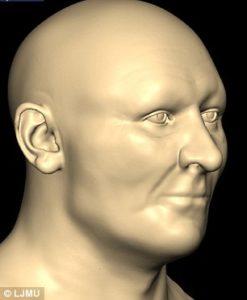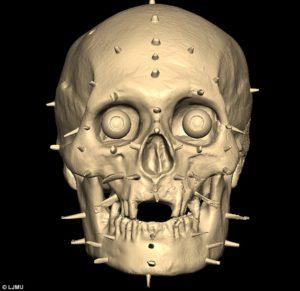 Robert the Bruce, who defeated England’s Edward II in the early 1300s and brought about Scotland’s independence, is back in the 3D printing news headlines again, a little over a year after his almost 700-year-old destroyed tomb was reconstructed and 3D printed. Facial reconstruction experts with Liverpool John Moores University (LJMU) recently completed a two-year project in collaboration with Glasgow University, and have released digital 3D images of the Scottish king, who was descended from Anglo-Norman nobles and Scottish aristocrats and beat the English at Bannockburn in 1314. The reconstructions were based on a cast of Robert the Bruce’s skull, which was held at the Hunterian Museum; historians say the skull was recovered, along with his skeleton, in the early 1800s from Dunfermline Abbey, and later re-interred.
Robert the Bruce, who defeated England’s Edward II in the early 1300s and brought about Scotland’s independence, is back in the 3D printing news headlines again, a little over a year after his almost 700-year-old destroyed tomb was reconstructed and 3D printed. Facial reconstruction experts with Liverpool John Moores University (LJMU) recently completed a two-year project in collaboration with Glasgow University, and have released digital 3D images of the Scottish king, who was descended from Anglo-Norman nobles and Scottish aristocrats and beat the English at Bannockburn in 1314. The reconstructions were based on a cast of Robert the Bruce’s skull, which was held at the Hunterian Museum; historians say the skull was recovered, along with his skeleton, in the early 1800s from Dunfermline Abbey, and later re-interred.
 All existing depictions of the Scottish king, such as the monument at the Bannockburn battle memorial, were based on speculation, or the death mask seen on his tomb. There have been a few modern facial reconstructions. But now, thanks to 3D scanning and printing, we are actually able to see digital images of the great warrior, which depict him as a powerful, muscular man with large, broad features. The king had a powerful physique, and when he was younger, would have been a match for today’s superathletes. They can also tell that he was privileged, and so ate a very good diet during his life.
All existing depictions of the Scottish king, such as the monument at the Bannockburn battle memorial, were based on speculation, or the death mask seen on his tomb. There have been a few modern facial reconstructions. But now, thanks to 3D scanning and printing, we are actually able to see digital images of the great warrior, which depict him as a powerful, muscular man with large, broad features. The king had a powerful physique, and when he was younger, would have been a match for today’s superathletes. They can also tell that he was privileged, and so ate a very good diet during his life.
Dr. Martin MacGregor, a Scottish history lecturer at Glasgow University, watched the discovery of the Richard III’s remains underneath a Leicester car park in 2012, and soon after approached Professor Caroline Wilkinson, a craniofacial identification expert and the director of the Face Lab at LJMU, about starting the project on Robert the Bruce, and the joint project began in earnest. Professor Wilkinson had also led the reconstruction of Richard III’s face, using the Face Lab’s craniofacial computer system and the 3D replication process of stererolithography.
Dr. MacGregor said, “I was aware of previous attempts to recreate the face of the skull linked to Robert the Bruce. The case of Richard III revealed how far the technology had advanced. I saw an opportunity to apply the technology to the Hunterian skull: first to test the credibility of its connection to Bruce, and then to try to add to our knowledge of Scotland’s greatest king.”
 What made their reconstruction of Robert the Bruce so difficult was that they did not have any DNA samples – before his re-interment, his skeleton and skull were sealed in pitch, so the researchers were unable to extract any usable DNA. So they had to rely on statistics, and their faith in the historical record, to speculate that he had brown hair and eyes. But one thing they could tell from the skull cast were apparent signs of leprosy, disfiguring his upper jaw and nose. Historians believe that the disease would have weakened him many times in his later life and ultimately caused his death. So one set of the digital images created show an older, more marked face with its leprosy scars.
What made their reconstruction of Robert the Bruce so difficult was that they did not have any DNA samples – before his re-interment, his skeleton and skull were sealed in pitch, so the researchers were unable to extract any usable DNA. So they had to rely on statistics, and their faith in the historical record, to speculate that he had brown hair and eyes. But one thing they could tell from the skull cast were apparent signs of leprosy, disfiguring his upper jaw and nose. Historians believe that the disease would have weakened him many times in his later life and ultimately caused his death. So one set of the digital images created show an older, more marked face with its leprosy scars.
“Using the skull cast, we could accurately establish the muscle formation from the positions of the skull bones to determine the shape and structure of the face,” said Professor Wilkinson. “But what the reconstruction cannot show is the colour of his eyes, his skin tones and the colour of his hair. We produced two versions – one without leprosy and one with a mild representation of leprosy. He may have had leprosy, but if he did it is likely that it did not manifest strongly on his face, as this is not documented.”
 Robert the Bruce, a fourth grandson through a female line of King David I from the 12th century, believed he had an obvious claim to the Scottish throne, after John Balliol was taken under English custody, and became the country’s king in exile in France. He killed his rival for the throne, John Comyn, in 1306, and carried on the resistance movement to the country’s English domination started by William Wallace (portrayed by Mel Gibson in the 1995 film “Braveheart”). Bruce took the throne a year after Wallace was captured and killed in London. Even though this move was considered controversial at the time, as Balliol was still alive, he did secure Scottish independence when he eventually defeated Edward II. Discuss in the Robert the Bruce forum at 3DPB.com.
Robert the Bruce, a fourth grandson through a female line of King David I from the 12th century, believed he had an obvious claim to the Scottish throne, after John Balliol was taken under English custody, and became the country’s king in exile in France. He killed his rival for the throne, John Comyn, in 1306, and carried on the resistance movement to the country’s English domination started by William Wallace (portrayed by Mel Gibson in the 1995 film “Braveheart”). Bruce took the throne a year after Wallace was captured and killed in London. Even though this move was considered controversial at the time, as Balliol was still alive, he did secure Scottish independence when he eventually defeated Edward II. Discuss in the Robert the Bruce forum at 3DPB.com.
Subscribe to Our Email Newsletter
Stay up-to-date on all the latest news from the 3D printing industry and receive information and offers from third party vendors.
You May Also Like
Further Understanding of 3D Printing Design at ADDITIV Design World
ADDITIV is back once again! This time, the virtual platform for additive manufacturing will be holding the first-ever edition of ADDITIV Design World on May 23rd from 9:00 AM –...
3D Printer Maker EVO-tech Reborn as NEVO3D — Once More With Feeling
EVO-tech was a 3D printing service and original equipment manufacturer established in 2013 and based in Schörfling am Attersee, Austria. The company produced high-quality material extrusion systems featuring linear bearings,...
3D Systems Brings 3D Printed PEEK Cranial Implant to the U.S. with FDA Clearance
For more than 10 years, 3D Systems (NYSE:DDD) has worked hand-in-hand with surgeons to plan over 150,000 patient-specific cases, and develop more than two million instruments and implants from its...
CDFAM Returns to Berlin for Second Annual Symposium
The second CDFAM Computational Design Symposium is scheduled for May 7-8, 2024, in Berlin, and will convene leading experts in computational design across all scales. Building upon the first event...































